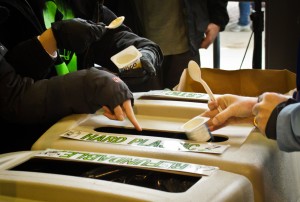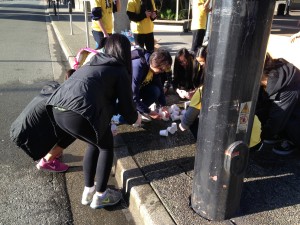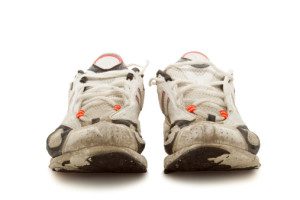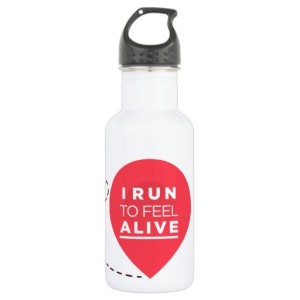Eco-friendly racing: Reduce, reuse, recycle, RUN
Green Chair is a Canadian community-based organization working to spread information on sustainability and protect the environment. They have worked closely with several races in B.C. to make the events eco-friendly. Thanks to Green Chair and the cooperative participants at this year’s Vancouver Sun Run, 100 per cent of the materials produced at the event were diverted. With 41,000 runners taking part, that was 3.2 tonnes of waste!
We chatted with Liliana Segal, one of the masterminds behind Green Chair recycling. When I told her I wanted to know more about how runners could get involved in the sustainability movement, she answered with a resounding, “Absolutely, this is my favourite topic!”
 Canadian Running: How did Green Chair come to be?
Canadian Running: How did Green Chair come to be?
Liliana Segal: I was an event planner for many years. When you’re part of planning committees, you tend to get a position as a “chair.” I served as many things, food chair, decorating chair, but when I saw how wasteful events could be, I used to joke that I wished I was the “green chair.” So that’s how the name of our business came to be.
Eight years ago I ended up going back to school and studying sustainability management at the University of British Columbia. Then Green Chair was born! In the beginning, we were completely volunteer-based, we had to help run weddings in order to support our recycling operations. For the last couple of years, we’ve seen a shift in people’s valuation of eco-friendly events and we’ve transitioned into a for-hire business model.
CR: What’s the process like to make a race eco-friendly?
LS: I’d like to take all the credit, but the most important step to an eco-friendly race is race organizers that are thinking ahead. We work extensively with the race directors and committees for events that we’re involved with, like the Vancouver Sun Run and Modo Runoff.
We map out all the different types of materials that may be produced by the event. Paper, plastic, organics etc. I think one of the most important things that we do is that we have a volunteer manning each disposal station. So they’re there to offer information, answer questions and runners especially seem really receptive to making sure they’re getting their waste to where it will do the least environmental damage.
We talk to the race organizers about things like what food they’ll be serving after the race. The thing with a banana peel is that you put it in the compost, and then it becomes soil! But if you have things like yogurt containers, that is trickier. Not very many people know that even if you recycle a yogurt container in the proper bin, if it still has any yogurt in it, the whole bin becomes contaminated. Our volunteers are there to make sure stuff like that is avoided, but part of our race day clean-up duty is to go through all the material collected and make sure that containers are rinsed out and nothing is contaminating the recycling process.
CR: Your site says that at the 2015 Modo Spring Runoff, you helped the event create negative waste. What does that mean?
 LS: Negative waste means that people brought hard-to recycle items to the event, in order to get help making sure they end up in the right place. Once again, this is really the work of the race directors. We tell them what participants can bring and then they’re the ones getting the message out.
LS: Negative waste means that people brought hard-to recycle items to the event, in order to get help making sure they end up in the right place. Once again, this is really the work of the race directors. We tell them what participants can bring and then they’re the ones getting the message out.
At races, the number one thing that we have runners bring are their old shoes that they’re no longer using for training. We have several organizations that we work with to make sure that those sneakers are getting a second lease on life, rather than ending up in the trash. I know you runners sometimes go through a pair of shoes a month!
CR: Where do you see eco-friendly racing headed in the future?
LS: I would love to see more race directors making the mitigation of environmental impact a priority of their events. We’re currently based out West and I would love to see our model spread all the way across the country. I might be biased, but to me it seems that runners want their races to be eco-friendly. In my experiences working at running events, I would say that 95 per cent of the runners that use our recycling stations actually say “thank you for doing this!” They’re the type of people that want to respect the environment.
What can runners do?
Race days are hard obviously, unless you’re carrying a bottle with you the whole time, but in your everyday training life, make sure you’re utilizing a reusable water instead of disposable plastic ones.
Have a compost bin at home
Runners eat a lot of fruits and veggies and other organic materials. Make sure you’re making the most of this by composting them, so that the nutrients can return to the Earth.
Preserve the life of your gear
Not only is this good for the environment, it’s good for your wallet as well. Wash your running clothes in cold water to make them last longer (and to save energy). Let them dry outside on a laundry line, or in the basement on a drying rack.
Find a secondary use for gear
If you have running clothes that are really worn out, or have a hole in them, you can cut them up to use as cleaning rags. If you have a yoga mat that is too worn out for use, slip it under a treadmill or elliptical to protect the floor, or see if your local animal shelter wants it for padding for four-legged friends. Some brands, like Patagonia, accept their clothes back for recycling when you can’t wear them any longer.



